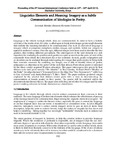Linguistics Elements and Meaning: Imagery as a Subtle Communication of Ideologies in Poetry.
Abstract
Language is the vehicle through which ideas are communicated. In order to have a holistic criticism of the works of art, the critic is called upon to break down language into small elements that embody the meaning intended to be communicated. One such an element of language is imagery which encompasses metaphors, similes, images, and symbols. Artists use imagery to appeal to audience’s senses. Over the ages, different images have been used to describe the two genders, thus inviting different perceptions. The interrogation of the said elements is a rich repository for analyzing the position each gender occupies as seen from the point of view of the community from which the artist draws his or her materials. As such, gender subjugation and or elevation can be analyzed through interrogating the images that poets employ to bring forth their thematic concerns. By analyzing the images, one is able to identify traces of gender subjugation or otherwise in the poetry of the early East African Poets whose poetry is informed by the (then newly) acquired Western education. This paper interrogates five poems by East African early male poets namely: “The Motoka” by Theo Luzuka, Richard Ntiru’s “Rhythm of the Pestle”, Jonathan Kariara’s “A Leopard Lives in the Muu Tree” Eric Ng’amaryo’s “I will Cling to Your Garment” and Austin Bukenya’s “I Met a Thief.” The paper analyses gendered images employed by the selected East African (male) poets with a view to deconstructing the representation of female gender in their poetry. The poems will be analyzed within the deconstructionist literary theory. The paper aims at finding out whether the images used by male poets in making reference to female characters are chauvinistic.

